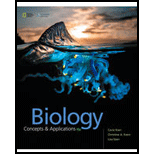
Concept explainers
Introduction:
“Endangered species” become extinct in all or part of its range and threatened species are vulnerable to become endangered in the near future. Not all rare species are threatened or endangered. In the United States, endangered and threatened species are listed by the United States Fish and Wildlife Service (USFWS).
Answer to Problem 1SA
Correct answer: An endangered species has population level so low it is at great risk of extinction in the near future. Therefore option b. is correct.
Explanation of Solution
Reasons for the correct statement:
Option b. is given as “endangered.”
ESA describes an "endangered species" as a species that is in the risk of extinction throughout all or a particular area of its geographic range. Therefore option b. is correct.
Reasons for incorrect statements:
Option a. is given as “endemic.”
Endemic species are organisms that are restricted to one geographic region. For example, lemurs are endemic and restricted to Madagascar. However endemic species are not at great risk of extinction. Therefore option a. is not correct.
Option c. is given as “threatened.”
The Endangered Species Act (ESA) describes a threatened species as a species that is vulnerable to become an “endangered species.” However threatened species are not at great risk of extinction. Therefore option c. is not correct.
Option d. is given as “Indicator.”
An indicator species is a species that represents the overall condition of an environment. For example, Tubifex tubifex is a worm that lives in the mire of streams and lakes. This worm represents overall condition environment such as water quality, low-oxygen levels or heavy metal contamination. However, indicator species are not at great risk of extinction. Therefore option d. is not correct.
Hence, option a., b., and d. are incorrect.
Endangered species has population levels so low it is at great risk of extinction in the near future.
Want to see more full solutions like this?
- Molecular Biology Question You are working to characterize a novel protein in mice. Analysis shows that high levels of the primary transcript that codes for this protein are found in tissue from the brain, muscle, liver, and pancreas. However, an antibody that recognizes the C-terminal portion of the protein indicates that the protein is present in brain, muscle, and liver, but not in the pancreas. What is the most likely explanation for this result?arrow_forwardMolecular Biology Explain/discuss how “slow stop” and “quick/fast stop” mutants wereused to identify different protein involved in DNA replication in E. coli.arrow_forwardMolecular Biology Question A gene that codes for a protein was removed from a eukaryotic cell and inserted into a prokaryotic cell. Although the gene was successfully transcribed and translated, it produced a different protein than it produced in the eukaryotic cell. What is the most likely explanation?arrow_forward
- Molecular Biology LIST three characteristics of origins of replicationarrow_forwardMolecular Biology Question Please help. Thank you For E coli DNA polymerase III, give the structure and function of the b-clamp sub-complex. Describe how the structure of this sub-complex is important for it’s function.arrow_forwardMolecular Biology LIST three characteristics of DNA Polymerasesarrow_forward
- Molecular Biology RNA polymerase core enzyme structure contains what subunits? To form holo enzyme, sigma factor is added to core. What is the name of the structure formed? Give the detailed structure of sigma factor and the function of eachdomain. Please help. Thank youarrow_forwardMolecular Biology You have a single bacterial cell whose DNA is labelled with radioactiveC14. After 5 rounds of cell division, how may cells will contain radioactive DNA? Please help. Thank youarrow_forward1. Explain the structure and properties of atoms and chemical bonds (especially how they relate to DNA and proteins). Also add some pictures.arrow_forward
- 1. In the Sentinel Cell DNA integrity is preserved through nanoscopic helicase-coordinated repair, while lipids in the membrane are fortified to resist environmental mutagens. also provide pictures for this question.arrow_forwardExplain the structure and properties of atoms and chemical bonds (especially how they relate to DNA and proteins). Also add some pictures.arrow_forwardIn the Sentinel Cell DNA integrity is preserved through nanoscopic helicase-coordinated repair, while lipids in the membrane are fortified to resist environmental mutagens. also provide pictures for this question.arrow_forward
 Biology (MindTap Course List)BiologyISBN:9781337392938Author:Eldra Solomon, Charles Martin, Diana W. Martin, Linda R. BergPublisher:Cengage Learning
Biology (MindTap Course List)BiologyISBN:9781337392938Author:Eldra Solomon, Charles Martin, Diana W. Martin, Linda R. BergPublisher:Cengage Learning
 Concepts of BiologyBiologyISBN:9781938168116Author:Samantha Fowler, Rebecca Roush, James WisePublisher:OpenStax College
Concepts of BiologyBiologyISBN:9781938168116Author:Samantha Fowler, Rebecca Roush, James WisePublisher:OpenStax College Biology Today and Tomorrow without Physiology (Mi...BiologyISBN:9781305117396Author:Cecie Starr, Christine Evers, Lisa StarrPublisher:Cengage Learning
Biology Today and Tomorrow without Physiology (Mi...BiologyISBN:9781305117396Author:Cecie Starr, Christine Evers, Lisa StarrPublisher:Cengage Learning Human Biology (MindTap Course List)BiologyISBN:9781305112100Author:Cecie Starr, Beverly McMillanPublisher:Cengage Learning
Human Biology (MindTap Course List)BiologyISBN:9781305112100Author:Cecie Starr, Beverly McMillanPublisher:Cengage Learning





